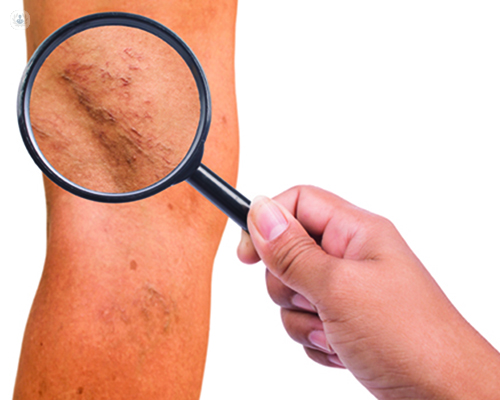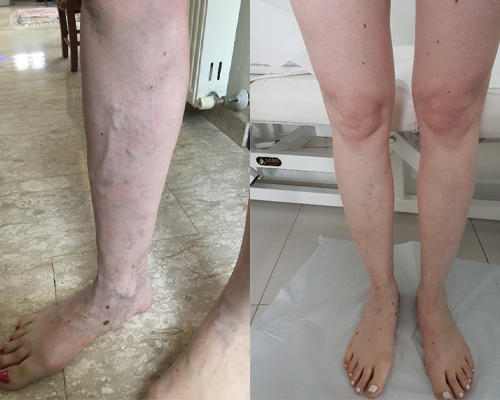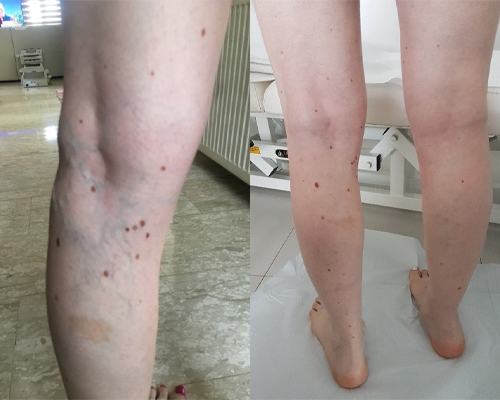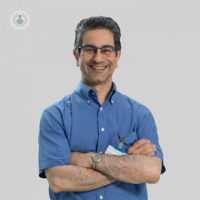EVLA: Endovenous laser ablation for varicose veins
Escrito por:Varicose veins can be treated in a variety of ways. In this article, Professor Vassilis Hadjianastassiou goes into thorough explanation about what to expect in the modern EVLA procedure and afterwards.

What is EVLA?
EVLA is a modern, non-surgical and evidence-based method of treating varicose veins that is well-tested and tried. Alternative options for treating varicose veins include: no treatment, compression stockings, surgery or injections into the varicose veins (sclerotherapy). Other methods are also available, such as using microwave (radiofrequency) energy, instead of laser, to destroy the vein and sealing the veins with glue.
Since 2004, EVLA has come into widespread use in specialist centres and in the past 15 years it has been perfected. It is a quick, minimally invasive alternative to traditional vein stripping. It has a shorter recovery time than open surgery and patients can walk out within a couple of hours. The vein is destroyed by inserting a laser fibre and laser energy heats the inside of the vein (usually 8 watts, which is much less than the power of a light bulb). The procedure is performed through a tiny cut at the knee level, usually only one to two millimetres long. Several local anaesthetic injections in the leg are necessary, which may result in temporary bruising. The body then naturally absorbs the destroyed veins. It avoids scarring and bleeding and can be performed under local anaesthesia if the patient wants to avoid a general anaesthetic. Light sedation is administered by an anaesthetist during the procedure as the local anaesthetic injections may be uncomfortable for a minute until the anaesthetic works. Some patients request to also have the smaller bulging veins in the leg removed through tiny cuts (stab avulsions). These cuts are usually closed with adhesive tape and do not require stitches, as they are really small. The avulsions are performed after the laser part of your treatment has taken place. This part of the procedure is not required by all patients; however, you can discuss it with your surgeon. When both the laser and avulsions take place, it is generally advisable for patients to undergo a gentle general anaesthetic, rather than sedation and local anaesthetic.
What are the complications?
There are potential complications with any medical procedure. As the endovenous laser procedure is minimally invasive, there have been minimal complications experienced. Serious complications after EVLA are very rare. Sometimes the procedure cannot be completed as planned and has to be postponed for a later date, or has to be converted to an open surgical procedure. This can happen in less than 1 in 100 cases with both EVLA and foam sclerotherapy when it becomes technically impossible to get access to the veins or to position the instruments correctly through the vein.
Expect to have a considerable amount of bruising along the thigh with EVLA. This largely disappears by two weeks but can take longer sometimes to fully resolve. Wearing compression stockings (or bandages) for four days and nights initially and then compression stockings for another ten days (during the day only) helps significantly to minimise the bruising and any discomfort. A feeling of tightness along the length of the vein on the inner aspect of the thigh as the vein contracts over the first four weeks is another common side effect that occurs in most patients. In some patients this can be uncomfortable enough to warrant taking some simple anti-inflammatory tablets, like Ibuprofen (e.g. nurofen) which will usually relieve it adequately. Occasionally you can develop some thread veins following EVLA, normally along the course of the vein that has been lasered but can be in other locations on the leg. If this occurs, then you will require microsclerotherapy injections to clear these up in the outpatient clinic. This is a separate cosmetic procedure and it is not necessary to be done.
More serious complications are very rare with EVLA but in theory, it would be possible for any of the following to occur:
- Deep vein thrombosis and pulmonary embolism. This is the development of a clot occurring in the large deep veins inside the leg or lower tummy. If such a clot travels up to the lungs, this is called a pulmonary embolism, which can cause pain in the chest, breathlessness and even death. We advise all our patients to walk at least 45 to 60 minutes every day (4 to 5 kilometres) for the first week after the procedure which from experience seems to afford them excellent protection.
- Skin burns. This was reported in the scientific literature in the first cases of using the laser machinery 15 years ago
- Nerve damage. It is not surprising that nerves lying close to the veins having treatment may be damaged, leading to patches of numbness or tingling on the skin, but it is usually mild and temporary. Very seldomly does this continue for longer than three months.
- Leg swelling
- Infection at the injection sites – theoretically possible but have never seen it in our clinic

Before and after images of varicose veins in the front of a patient's legs with EVLA treatment.

Before and after images of varicose veins in the back of a patient's legs with EVLA treatment.
What happens after treatment?
Patients can walk immediately after the procedure and may be allowed home within a few hours after the end of treatment. You will be advised to wear compression stockings (and bandages for the first four days) during the day only (remove them at night) for up to two weeks. You should resume normal activity as soon as possible, normally within two to three days. Hot baths and vigorous activity such as gym workouts should be avoided in the first two weeks. Pain and discomfort for most patients are minimal and usually improve within a few days but can last for longer in others. Flying and excessively long journeys should be avoided for the first two to four weeks due to a slightly increased risk of deep vein thrombosis (DVT). Most patients experience some bruising or pain for up to two weeks, or a tightening sensation along the length of the treated vein but this is usually mild. Simple painkillers like paracetamol and anti-inflammatory drugs like Ibuprofen relieve it very well.
Will patients need further treatment?
If patients are having treatment just to relieve symptoms, then no further treatment beyond the laser of the main vein is usually necessary. Most patients however wish also to improve the appearance of their veins and of these about 80 per cent will require further treatment to achieve that. The main varicosities normally become much less obvious after EVLA but all varicosities rarely disappear completely. Avulsions (phlebectomies) under local anaesthetic or foam sclerotherapy in the outpatient clinic are additional treatments for these smaller varicosities. More often these additional treatments can be undertaken after a delay of six weeks, as this is the amount of time it takes for the effect of EVLA to show. The commonest means of handling residual varicose veins after EVLA is foam sclerotherapy and it is highly effective.
If you would like to undergo EVLA treatment for your varicose veins, make a consultation with Professor Vassilis Hadjianastassiou via his Top Doctors profile.


